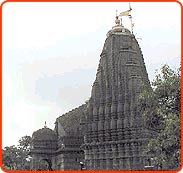
Shri Trimbakeshwar Temple is located at a distance of about 30-km from Nasik in Maharashtra near the mountain named Brahmagiri from which the river Godavari flows. Trimbakeshwar Temple is revered as one of the 12 Jyotirlinga shrines of Shiva and as the source of the river Godavari. Just as Ganga is known as Bhagirathi and is one of the most important river in North India, in the same way, Godavari is also known as
Gautami Ganga and is the most sacred river in South India.
According to Shiv Purana, it is because of the earnest request of Godavari, Gautam Rishi and other gods that Lord Shiva agreed to reside here and assumed the famous name Trimbakeshwar. Interestingly, locals refer to the river here as Ganga and not as Godavari. All the heavenly Gods promised to come down to Nasik, once in twelve years, when Jupiter resides in the zodiac sign of Leo. On this a grand fair is organized at this place. Devotees take a holy bath in the Gautami Ganga and then seek the blessings of Trimbakeshwar.
Legend Behind Trimbakeshwar TempleLegend goes that a sage name
Gautam Muni resided on the Brahmagiri hill with his wife Ahilya. By virtue of his devotion, the sage received from Varuna, a bottomless pit from which he received an inexhaustible supply of grains and food. The other rishis, jealous of his fortune, arranged for a cow to enter his granary and caused it to die as Gowtam Rishi attempted to ward it off with a bunch of Darbha grass.
Gautam Rishi, therefore, worshipped Lord Shiva to bring the Ganga down to his hermitage to purify the premises. Pleased with devotion, Shiva requested Ganga to flow down and make Sage Gautam pure. After that Ganga flowed down. Lord Shiva told Ganga to stay there eternally for the good of everyone. All the Gods started singing the praises of Gautam Rishi, Ganga and Lord Shiva. On the request of all the Gods, Lord Shiva resided by the river Gautami by the name Trimbakeshwar (one of the Jyotirlingas) . Hindus believe that Trimbak Jyotirlinga is one, which fulfills everyone’s desires. It emancipates all from their sins and miseries.
Another popular legend behind Trimbakeshwar Temple is the legend of
Lingodbhava manifestation of Shiva. It says once Brahma and Vishnu searched in vain to discover the origin of Shiva who manifested himself as a cosmic column of fire. Brahma lied that he had seen the top of the column of fire and was hence cursed that he would not be worshipped on earth. In turn Brahma cursed Shiva that he would be pushed underground. Accordingly, Shiva came down under the Brahmagiri hill in the form of Tryambakeshwar. Trimbakeshwar Temple is the only place where Shivlinga is not out but it’s inside the floor.
Some scholars say that Goddess Parvati also came down along Lord Shiva and Ganga. The place is therefore called Tryambakeshwa (three lords). Others believe that the place is so called because of the presence of three Shivlinga of Brahma, Vishnu and Mahesh. The Shivlinga of Lord Mahesh has always-flowing water among the three Shivlingas.
Structure of Trimbakeshwar TempleTrimbakeshwar Temple is an ancient shrine, however the current structure is a result of the reconstruction efforts undertaken by the Peshwa Balaji Bajirao in mid 18th century. The temple is built of black stone in the Nagara style of architecture and is enclosed in a spacious courtyard. The sanctum internally a square and externally a stellar structure houses a small Shivalingam - Tryambaka. The sanctum is crowned with a graceful tower, embellished with a giant Amalaka and a golden kalasha. In front of the garbagriha and the antarala is a mandap with doors on all four sides. Three of these doorways are covered with porches and the openings of these porches are ornamented with pillars and arches. Curvilinear slabs rising in steps form roof of the mandapam. The entire structure is ornamented with sculptural work featuring running scrolls, floral designs, and figures of gods, yakshas, humans and animals.
The Shivalingam is seen in a depression on the floor of the sanctum. Water constantly oozes out from the top of the Shivalingam. Usually, the Shivalingam is covered with a silver mask but on festive occasions a golden mask with five faces, each with a golden crown covers it.
Kedarnath Temple in Himalayas
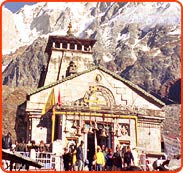
One of the holiest pilgrimages for the Hindus, Kedarnath Temple Jyotirlinga is located in the picturesque surroundings of Rudra Himalaya Range at a height of 12000 feet on a mountain named Kedar. Near Kedarnath is the source of the river Mandakini that joins Alakananda at Rudraprayag. This place is approximately 150 miles away from Hardwar and 132 miles north of Hrishikesh and is accessible by foot.
The temple at Kedarnath enshrining the Jyotirlingam of Shiva opens only 6 months a year (April-November) when the sun enters the zodiac sign of Aries and it is closed when the sun enters Scorpio. The priests then go to Ukhimath, where the worship of Kedareshwara is continued during the winter season.
Tradition has it that when undertaking Kedarnath Yatra pilgrims first visit Yamunotri and Gangotri and bring with them the holy waters from the sources of the rivers Yamuna and Ganga and offer abhishekams to Kedareshwara. The traditional pilgrim route is Haridwar - Rishikesh - Devaprayag - Tehri - Dharasu - Yamunotri - Uttar Kashi - Gangotri - Triyugnarayan - Gowrikund and Kedarnath. The alternative route to Kedar from Rishikesh is via Devprayag, Srinagar, Rudraprayag and Ukhimath.
Legend Behind Kedarnath TempleLegend goes that
Nara and Narayana - two incarnations of Vishnu performed severe penance in Badrikashraya of Bharat Khand, in front of a Shivalingam fashioned out of earth. Pleased with their devotion, Lord Shiva appeared in front of them and said that they may ask for a boon. Nar and Narayan requested Shiva to take up a permanent abode as a Jyotirlingam at Kedarnath so that all people who worship Shiva shall be freed from their miseries.
According to yet another popular legend related to Kedar Temple, Goddess Parvati worshipped Kedareshwar to unite with Shiva as Ardhanareeswarar. Besides, the Pandavas are believed to have visited this area several times. Arjuna is believed to have come here to pray to Shiva to obtain the coveted Pasupataastra. The other Pandavas are believed to have come here in search of him, where Draupadi came across the heavenly lotus Kalyana Saugandikam, and requested Bhima to bring here some more of the same. It was during his venturing out to seek these flowers that Bhima met Hanumaan.
Significance of Kedarnath TempleLocated in the lofty Himalayas, Kedarnath Temple is one of the best known Shivasthalams in India and is considered to be one of the most sacred pilgrimage centers of the country. It is believed that by praying to Kedareshwar, one can get all his desires fulfilled. Importance of the shrine can be further understood from the beliefs that Upamanyu prayed to Lord Shiva in this place in Satayuga while in Dwapar, the Pandavas worshipped Lord Shiva here. Even the spiritual leader Adi Sankaracharya is closely associated with Kedarnath.
Structure of Kedarnath TempleKedarnath Shrine is scenically placed amidst the lofty, snow - covered mountains and grassy meadows covering the valleys. Immediately behind the temple is the high Keadardome peak, which can be sighted from great distances. It is believed that the temple of Kedarnath was constructed by the Pandavas. At the entrance of the temple is the statue of Nandi, the divine bull of Shiva. Walls inside the temple are exquisitely carved with images. The revered Shiva Lingam housed in the temple is in the unusual pyramidal form.
Grishneshwar Temple in Daulatabad
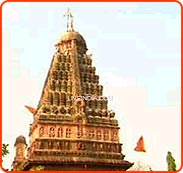
Grishneshwar Temple is an ancient pilgrimage site revered as the abode of one of the 12 Jyotirlinga manifestation of Lord Shiva. The Grishneshwar Jyotirlinga shrine is located at a village called Verul, which lies 20 km from Daulatabad (near Aurangabad in Maharashtra) and approximately 100 kms from Manmad station. Located close to Daulatabad (once known as Devagiri) is the popular tourist attractions Ajanta - Ellora.
The Grishneswar Temple was constructed by Ahilyabhai Holkar who also re-constructed the
Kashi Viswanatha Temple at Varanasi and the Vishnu Paada Temple at Gaya. The Grishneshwar Temple is also known by several other names like Kusumeswarar, Ghushmeswara, Grushmeswara and Grishneswara.
Legend Behind Grishneshwar TempleAccording to Shivapuran, in the southern direction, on a mountain named Devagiri lived a Brahmin called Brahmavetta Sudharm along with his wife Sudeha. The couple did not have a child because of which Sudeha was sad. Sudeha prayed and tried all possible remedies but in vain. Frustrated of being childless, Sudeha got her sister Ghushma married to her husband. On the advice of her sister, Ghushma used to make 101 lingas, worship them and discharge them in the near by lake.
With the blessings of Lord Shiva, Ghushma gave birth to a baby boy. Because of this, Ghushma became proud and Sudeha started feeling jealous towards her sister. Out of jealously, one night she killed Ghushma’s son and threw him in the lake where Ghushma used to discharge the lingas.
Next morning, Ghushmas and Sudharm got involved in daily prayers and ablutions. Sudeha too, got up and started performing her daily choirs. Ghushma’s daughter-in- law, however, saw stains of blood on her husband’s bed and parts of the body drenched in blood. Horrified, she narrated everything to mother-in-law Ghushma who was absorbed in worshipping Shiva. Ghushma did not deter. Even her husband Sudharma did not move an inch. Even when Ghushma saw the bed drenched in blood she did not break down and said he who has given me this child shall protect him and started reciting ‘Shiva-Shiva’. Later, when she went to discharge the Shivalingas after prayers she saw her son coming. Seeing her son Ghushma was neither happy nor sad. At that time Lord Shiv appeared before her and said - I am pleased with your devotion. Your sister had killed your son. Ghushma told Lord to forgive Sudeh and emancipate her. Pleased with her generosity, Lord Shiva asked her another boon. Ghushma said that if he was really happy with her devotion then he should reside here eternally for the benefit of the multitudes in form of a Jyotirling and may you be known by my name. On her request, Lord Shiva manifested himself in the form of a Jyotirling and assumed the name Ghushmeshwar and the lake was named as Shivalaya thereafter.
 Somnath Temple Jyotirlinga is situated at Somnath Patan (the south coast of Saurashtra), near Veraval in (Prabhas Kshetra) Kathaiwad district in Gujarat. Somnath is considered to be the first of the 12 Jyotirlingas of Shiva and is a revered pilgrimage center in India.
Somnath Temple Jyotirlinga is situated at Somnath Patan (the south coast of Saurashtra), near Veraval in (Prabhas Kshetra) Kathaiwad district in Gujarat. Somnath is considered to be the first of the 12 Jyotirlingas of Shiva and is a revered pilgrimage center in India.

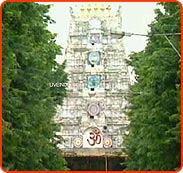 Mallikarjun Temple is situated on Shri Shaila Mountain by the banks of the Patal Ganga, Krishna River in the southern state of Andhra Pradesh. Also known as Kailash of the South, Mallikarjuna constitutes one of the 12 Jyotirlingam shrines of Shiva and is one of the greatest Shaivaite shrines in India. The presiding deities of Mallikarjuna Temple are Mallikarjuna (Shiva) and Bhramaramba (Devi). Every year there is a fair organized on account of Mahashivratri.
Mallikarjun Temple is situated on Shri Shaila Mountain by the banks of the Patal Ganga, Krishna River in the southern state of Andhra Pradesh. Also known as Kailash of the South, Mallikarjuna constitutes one of the 12 Jyotirlingam shrines of Shiva and is one of the greatest Shaivaite shrines in India. The presiding deities of Mallikarjuna Temple are Mallikarjuna (Shiva) and Bhramaramba (Devi). Every year there is a fair organized on account of Mahashivratri.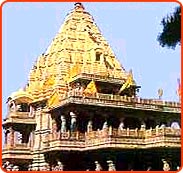 Mahakaleshwara Temple is located by the banks of river Kshipra, in the dense Mahakal forests in Ujjain, Madhya Pradesh. It is an important Shaivaite pilgrimage centre in North India and is revered as one of the 12 Jyotilinga manifestations of Shiva.
Mahakaleshwara Temple is located by the banks of river Kshipra, in the dense Mahakal forests in Ujjain, Madhya Pradesh. It is an important Shaivaite pilgrimage centre in North India and is revered as one of the 12 Jyotilinga manifestations of Shiva.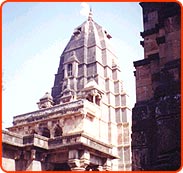 Omkareshwar Temple is situated on the mountain Mandhata by the banks of Narmada River in the Malva area in Madhya Pradesh. Omkareshwar Temple is one of the 12 revered Jyotirlinga shrines of Shiva. The temple is closely linked with Mammaleshwar Temple (situated on the south of river Narmada) as both the forms of Shiva have been counted as one.
Omkareshwar Temple is situated on the mountain Mandhata by the banks of Narmada River in the Malva area in Madhya Pradesh. Omkareshwar Temple is one of the 12 revered Jyotirlinga shrines of Shiva. The temple is closely linked with Mammaleshwar Temple (situated on the south of river Narmada) as both the forms of Shiva have been counted as one.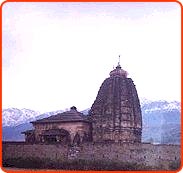 Vaidyanath Temple, also called Vaijnath Temple and Baidyanth Temple is located at Deoghar in the Santal Parganas region of Bihar in the south west of Keeul Station. Baidyanath shrine is revered as one of the twelve Jyotirlingams of Shiva. It may be noted that some schools of thought believe Vaidyanath near Parali in Andhra Pradesh to be the Vaidyanatha Jyotirlingam.
Vaidyanath Temple, also called Vaijnath Temple and Baidyanth Temple is located at Deoghar in the Santal Parganas region of Bihar in the south west of Keeul Station. Baidyanath shrine is revered as one of the twelve Jyotirlingams of Shiva. It may be noted that some schools of thought believe Vaidyanath near Parali in Andhra Pradesh to be the Vaidyanatha Jyotirlingam.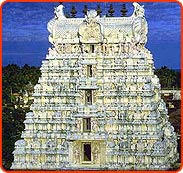 Rameshwaram Temple is situated in the island of Rameswaram, off the Sethu coast of Tamil Nadu and is reached via the Pamban Bridge across the sea. The huge temple is known for its long ornate corridors, towers and 36 theerthams.
Rameshwaram Temple is situated in the island of Rameswaram, off the Sethu coast of Tamil Nadu and is reached via the Pamban Bridge across the sea. The huge temple is known for its long ornate corridors, towers and 36 theerthams.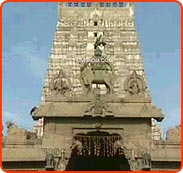 Nageshwar Temple or Nagnath Temple is located on the route between Gomati Dwarka and the Bait Dwarka Island on the coast of Saurashtra in Gujarat. The Jyotirlinga enshrined in the Temple of Nagnath is known as Nageshwar Mahadev and attracts thousands of pilgrims all round the year. This powerful Jyotirlinga symbolizes protection from all poisons. It is said that those who pray to the Nageshwar Linga become free of poison. The Rudra Samhita sloka refers to Nageshwar with the phrase 'Daarukaavane Naagesham'.
Nageshwar Temple or Nagnath Temple is located on the route between Gomati Dwarka and the Bait Dwarka Island on the coast of Saurashtra in Gujarat. The Jyotirlinga enshrined in the Temple of Nagnath is known as Nageshwar Mahadev and attracts thousands of pilgrims all round the year. This powerful Jyotirlinga symbolizes protection from all poisons. It is said that those who pray to the Nageshwar Linga become free of poison. The Rudra Samhita sloka refers to Nageshwar with the phrase 'Daarukaavane Naagesham'.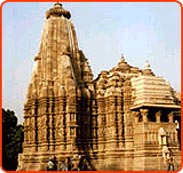 Vishwanath Temple is located amidst the crowded lanes in the holy city of Varanasi also known as Kashi and Benares. The Vishwanath Temple enshrines one of the twelve Jyotirlingams of Lord Shiva and is one of the most revered pilgrimage sites for Hindus. It is believed that Varanasi is the point at which the first Jyotirlinga, the fiery pillar of light by which Shiva manifested his supremacy over other gods, broke through the earth’s crust and flared towards the heavens. More than the Ghats and even the Ganga, the Shivalinga installed in the temple remain the devotional focus of Varanasi. Millions of pilgrims converge here to perform an abhishekam to the sacred Jyotirlingam with sacred water of river Ganga.
Vishwanath Temple is located amidst the crowded lanes in the holy city of Varanasi also known as Kashi and Benares. The Vishwanath Temple enshrines one of the twelve Jyotirlingams of Lord Shiva and is one of the most revered pilgrimage sites for Hindus. It is believed that Varanasi is the point at which the first Jyotirlinga, the fiery pillar of light by which Shiva manifested his supremacy over other gods, broke through the earth’s crust and flared towards the heavens. More than the Ghats and even the Ganga, the Shivalinga installed in the temple remain the devotional focus of Varanasi. Millions of pilgrims converge here to perform an abhishekam to the sacred Jyotirlingam with sacred water of river Ganga. Shri Trimbakeshwar Temple is located at a distance of about 30-km from Nasik in Maharashtra near the mountain named Brahmagiri from which the river Godavari flows. Trimbakeshwar Temple is revered as one of the 12 Jyotirlinga shrines of Shiva and as the source of the river Godavari. Just as Ganga is known as Bhagirathi and is one of the most important river in North India, in the same way, Godavari is also known as Gautami Ganga and is the most sacred river in South India.
Shri Trimbakeshwar Temple is located at a distance of about 30-km from Nasik in Maharashtra near the mountain named Brahmagiri from which the river Godavari flows. Trimbakeshwar Temple is revered as one of the 12 Jyotirlinga shrines of Shiva and as the source of the river Godavari. Just as Ganga is known as Bhagirathi and is one of the most important river in North India, in the same way, Godavari is also known as Gautami Ganga and is the most sacred river in South India. One of the holiest pilgrimages for the Hindus, Kedarnath Temple Jyotirlinga is located in the picturesque surroundings of Rudra Himalaya Range at a height of 12000 feet on a mountain named Kedar. Near Kedarnath is the source of the river Mandakini that joins Alakananda at Rudraprayag. This place is approximately 150 miles away from Hardwar and 132 miles north of Hrishikesh and is accessible by foot.
One of the holiest pilgrimages for the Hindus, Kedarnath Temple Jyotirlinga is located in the picturesque surroundings of Rudra Himalaya Range at a height of 12000 feet on a mountain named Kedar. Near Kedarnath is the source of the river Mandakini that joins Alakananda at Rudraprayag. This place is approximately 150 miles away from Hardwar and 132 miles north of Hrishikesh and is accessible by foot. Grishneshwar Temple is an ancient pilgrimage site revered as the abode of one of the 12 Jyotirlinga manifestation of Lord Shiva. The Grishneshwar Jyotirlinga shrine is located at a village called Verul, which lies 20 km from Daulatabad (near Aurangabad in Maharashtra) and approximately 100 kms from Manmad station. Located close to Daulatabad (once known as Devagiri) is the popular tourist attractions Ajanta - Ellora.
Grishneshwar Temple is an ancient pilgrimage site revered as the abode of one of the 12 Jyotirlinga manifestation of Lord Shiva. The Grishneshwar Jyotirlinga shrine is located at a village called Verul, which lies 20 km from Daulatabad (near Aurangabad in Maharashtra) and approximately 100 kms from Manmad station. Located close to Daulatabad (once known as Devagiri) is the popular tourist attractions Ajanta - Ellora.


